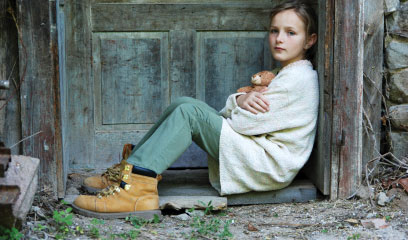 Whenever a child draws a picture of her family, it often includes the family dog, cat or other beloved animal. So when that family member passes away, it can cause a pain unlike anything that child has yet experienced.
Whenever a child draws a picture of her family, it often includes the family dog, cat or other beloved animal. So when that family member passes away, it can cause a pain unlike anything that child has yet experienced.
“It’s often their first loss,” says Dr. Tina Ellenbogen, an Eastside veterinarian with 20 years of experience in pet loss and bereavement. Because of that, she believes families should approach these tough situations with compassion and honesty. “However this loss is handled will set the stage for future losses.”
In her book, Grieving the Death of a Pet, Susan Chernak McElroy writes, “In this way, animals give us a most precious and intimate gift — the opportunity to learn how to live through grief, and to learn that we can live through grief.”
The importance of saying goodbye to your pet
For some children, the pet is their first best friend. A child who has gone through a divorce or other trauma might have felt safer with their furry friend than anyone else. For this reason, experts say, children must be given an opportunity to say goodbye.
The farewell can take various forms. If a pet is aging, a family can discuss the animal’s sickness and death over a period of time. As her family came to realize that their two 15-year-old terriers would not be around much longer, Lindzie Brett began finding ways for her daughters to do what she calls “last chapter” activities with their pets.
The Bothell family took portraits of the kids and dogs together, made plaster paw prints, and encouraged the girls, ages 3 and 6, to express themselves through art.
Depending on the maturity level of the child, many experts recommend allowing the child to see the body of the pet after death. The Bretts’ 6-year-old daughter Claire got to say goodbye to the body of her terrier, Budroe. “He was in his little bed; it helped make it real for her,” says Lindzie.
Allow children input on your pet's death
As with other aspects of children’s lives, many will cope best if they have been somewhat involved in the decision-making process. For children who are mature enough, Ellenbogen says that may even include the decision on when to euthanize an animal companion. Veterinarian Cecilia Soares writes on the Elliot Bay Animal Hospital’s Web site that parents should “… never force a child to be present at euthanasia and don’t ask any child to take full responsibility for the euthanasia decision.”
Carmack writes about the unique challenges of euthanizing a much-loved pet. An animal may become increasingly ill, or may be suffering injuries from an accident. At those times, Carmack says, “euthanasia is a merciful act of release — offering the gift of a gentle and graceful transition.”
Children do not like to see their pets suffer, either. Ellenbogen says a parent can explain to the child: “We are helping them to die peacefully.” Remember: Do not describe euthanasia as putting an animal “to sleep.” A parent must make it very clear that their pet’s body has stopped working or living, and will not wake up. For younger children, it reassures them that they can go to bed at night and wake up in the morning.
Depending on a child’s age and maturity level, a parent may wish them to be present at some or all of the euthanasia process. Ellenbogen often recommends that a child who is ready may watch the sedation process, but not necessarily the euthanasia itself. At that point, she explains, when the IV is inserted, reflex movements may occur that could upset a young child.
In any case, they should still allow children input in talks about where the animal may be buried or if it is to be cremated. A child who has given their heart to their companion will get a say in how their friend is memorialized. This, say bereavement experts, is critical for a child’s own emotional healing and growth.
Acknowledge your own grief over the pet's death
Carolyn Hobson of Seattle still cries when describing the loss last year of Billie, the family’s shepherd-collie mix. “When I was pregnant, she sat next to me when I was in the bathtub.”
For many families, the pets predate the children. In the Hobsons’ case, it meant that Carolyn felt more emotional about losing their pet than her daughter did. Hobson did what experts say is healthiest: She was open about her
own emotions, explaining to her daughter the sadness she felt. “I wanted her to know how I felt, because in general, I don’t think our culture is very open about death,” says Hobson.
A child’s grief — ages 6–8: Mary Hejnal, a bereavement specialist at Evergreen Hospital in Kirkland, says parents of children this age should expect many questions, like “How did Jake get sick?” “Why did a raccoon kill Ginger?”
At this age, children may still see death as reversible and temporary. As they grieve, they may regress more through their behavior rather than through words. Allow them chances to draw, paint and express themselves through art or stories.
A child’s grief — ages 8–10: At this stage, Hejnal says, children understand that all living things will die; they understand the finality. They will ask very specific, sometimes even gory questions: “What happens to the body?” Parents should not be alarmed by those questions.
Children this age, boys in particular, may seem upset one minute and very quickly shift modes (“So, when are we going to the movie?”). Again, parents should not be upset by this apparent lack of caring. Hejnal says this behavior does not mean children are over the pet’s death; they will come back to it, and possibly when you least expect it.
A child’s grief — ages 10–14: Children in their preteen and teenage years are able to think more abstractly. They may take a more adult approach to grief, moving from phases like denial to guilt to sadness and acceptance.
They may be more willing to talk with friends or family members other than their parents. Hejnal advises to not push kids this age to talk; rather, “Be available with a third ear, and watch them, because you might see something going on. If the child is a bit angrier, don’t take it away from them.”
Hejnal says children of all ages may act out or suffer through nightmares. Perhaps they will pick fights with siblings more than normal. Regression, she believes, is a way for children to back up to a time when they were more sure and felt safer.
Helping your child through a time that is traumatic for kids and parents alike is something your family will likely never forget. As Hejnal reminds us, “Children who mourn well will live well and love well.”
Hilary Benson is the mother of three children. She also counts a 15-year-old cat and 12-year-old dog as part of her family.
Resources for children who have lost a pet
Books for young children:
The Tenth Good Thing About Barney by Judith Viorst
Dog Heaven by Cynthia Rylant
I’ll Always Love You by Hans Wilhelm
Badger’s Parting Gifts by Susan Varley
Ocho Loved Flowers by Anne Fontaine
Books for older children:
Grieving the Death of a Pet by Betty J. Carmack
Fragile Tears by Alan Blain Cunningham
Workbook for younger kids:
I Remember: A Book About My Special Pet by Montgomery Press
Workbook for older kids:
Forever in My Heart: Remembering My Pet’s Life by Montgomery Press











